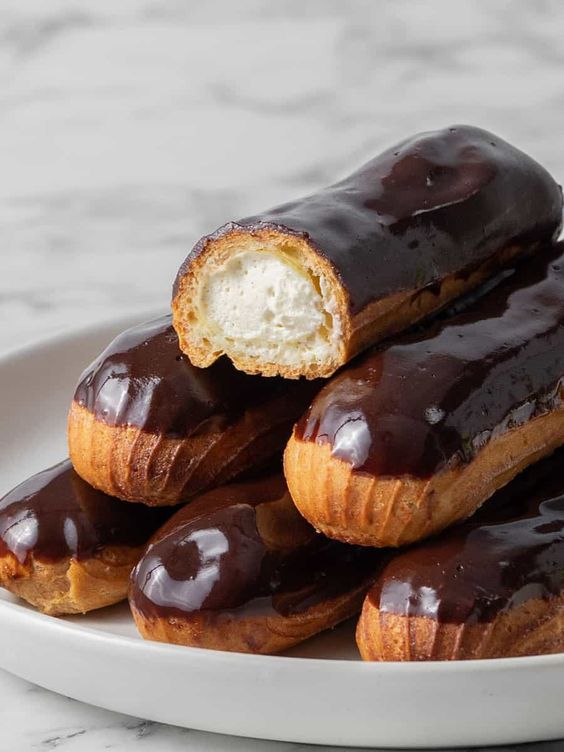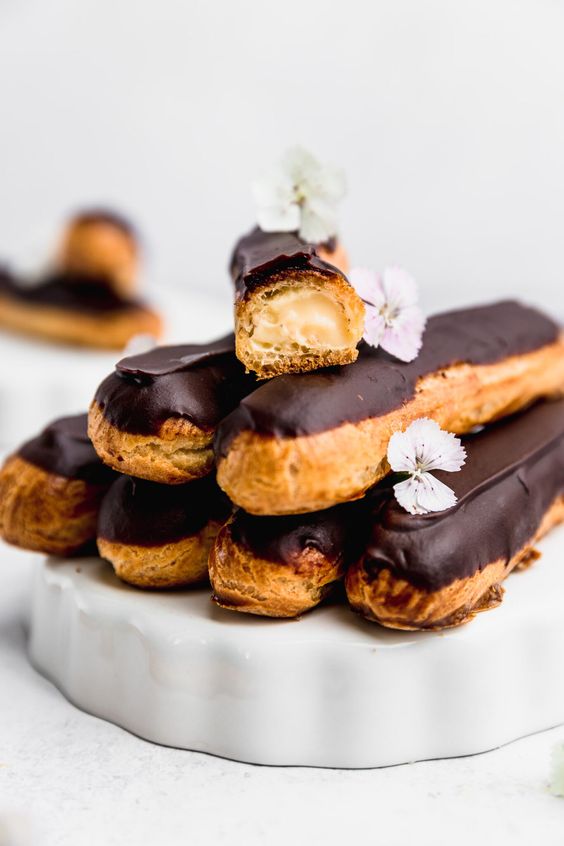Discover how to create perfect French chocolate éclairs with this foolproof step-by-step guide. Enjoy the delightful contrast of a crisp choux pastry filled with luscious Chantilly cream and finished with a glossy chocolate glaze.

WHAT MAKES CHOCOLATE ÉCLAIRS SO AMAZING?
Chocolate éclairs are a delightful French pastry, characterized by their elongated shape, which is typically filled with either pastry cream or Chantilly cream and topped with a rich chocolate glaze.
LIGHT AND CRISPY CHOUX PASTRY
Achieving a light, airy, and crispy choux pastry is simpler than you might think! The key lies in getting the right consistency, and I’ll guide you through the process with tips to test your dough before piping.
ENDLESS FILLING OPTIONS
While the classic fillings are pastry cream and Chantilly cream, the possibilities are virtually limitless! Feel free to experiment with different fillings to create a variety of flavors that suit your taste.
GLOSSY CHOCOLATE GLAZE
The chocolate glaze is a standout feature of classic éclairs, and I have a foolproof Chocolate Sauce Recipe to help you achieve that coveted glossy finish. I believe that a shiny glaze elevates these pastries, and my simple recipe uses easy-to-find ingredients.
PERFECT FOR ENTERTAINING
These éclairs make for elegant finger food at dinner parties, offering a touch of sophistication and a deliciously indulgent treat that your guests will love!
INGREDIENTS
Choux Dough
- 250 g water
- 70 g unsalted butter, cubed
- 1 tbsp granulated sugar
- 1/2 tsp fine salt
- 150 g bread flour (see notes)
- 4 large eggs (55 g each, room temperature; see notes)
- 75 g powdered sugar for dusting
Filling Options
- 1 batch of chocolate French pastry cream
- 1 batch of vanilla French pastry cream
- 1 batch of Chantilly cream
Chocolate Glaze
- 1 batch of chocolate sauce
INSTRUCTIONS
PREPARING THE CHOUX PASTRY DOUGH
Before You Start: Measure all ingredients and read through the recipe thoroughly. If using pastry cream as a filling, prepare it the day before. For Chantilly cream, make it while the éclairs are baking and store it in the fridge until needed.
- Preheat the Oven: Set a fan-forced oven to 190°C (375°F) or 210°C (410°F) for conventional ovens. Line two half-sheet baking trays with baking paper or silicone mats. If using baking paper, stick some choux pastry underneath to help it adhere.
- Heat Ingredients: In a large saucepan, combine the water, butter, and sugar. Heat over medium, stirring until the butter melts and the mixture starts to bubble at the edges.
- Add the Flour: Once bubbling, turn off the heat and quickly add the flour. Stir with a wooden spoon until a dough forms.
- Cook the Dough: Turn the heat back on and mix continuously for 1 minute. If using stainless steel, you’ll notice a film forming on the bottom; this won’t happen with non-stick pans.
- Cool the Dough: Remove from heat and let it cool for 10 minutes. Meanwhile, whisk the eggs together. Once the dough has cooled, add 1/4 of the eggs, mixing until fully combined. Repeat with the remaining eggs, adding them one quarter at a time.
TESTING THE DOUGH TEXTURE
The ideal texture is crucial. Typically, 4 eggs will suffice. To test, pinch some dough between two fingers; it should stretch without breaking and maintain a smooth, slightly shiny appearance. If it’s too soft, whisk an additional egg and add it 1 tablespoon at a time until you achieve the right consistency.
PIPING THE ÉCLAIRS
- Prepare the Piping Bag: Transfer the batter to a large piping bag fitted with a 1.2 cm (1/2 inch) French star piping tip, or a similar round tip.
- Pipe the Éclairs: Pipe 10 cm (4 inches) long éclairs on the prepared trays. The ends should be slightly wider than the middle. Use a wet finger to smooth the ends, preventing them from burning.
- Dust with Sugar: Lightly dust the tops with powdered sugar to help maintain their shape and add a hint of sweetness.
BAKING THE ÉCLAIRS
- Bake: Place in the middle rack of the oven and bake for 30-35 minutes, or until golden brown. After baking, slightly crack the oven door and place a wooden spoon in to keep it ajar for 5 minutes before removing the éclairs. Transfer them to a cooling rack to cool completely.
DECORATING THE ÉCLAIRS
- Prick the Bottoms: Use a fork or knife to prick two holes in the bottom of each éclair.
- Fill the Éclairs: Fill a piping bag fitted with a small round tip with your chosen filling. Insert the tip into the holes and fill the éclairs; they will feel heavier when filled.
- Glaze: While the éclairs are cooling, prepare the chocolate sauce. Dip the tops of each éclair into the sauce, ensuring an even coating, and let the excess drip off. Allow the chocolate to set.
SERVING SUGGESTIONS
I prefer serving my éclairs chilled from the fridge, but they can also be enjoyed at room temperature.
Notes
- Bread Flour: Using bread flour adds a chewier texture, but all-purpose flour can be used as a substitute.
- Eggs: Ensure eggs are at room temperature for optimal mixing. The number of eggs needed can vary; aim for a stretchy dough that holds its shape without being too soft.
- Storage: Store baked éclairs in an airtight container at room temperature for up to three days, or freeze for up to two weeks.
- Fillings: Feel free to experiment with different fillings! Chocolate and vanilla pastry creams are traditional, but Chantilly cream is a delightful alternative.
- Nutrition: Nutritional information is based on one éclair and does not include chocolate sauce or fillings. For specific nutrition details on those, refer to their respective recipes.
NUTRITION INFORMATION (PER ÉCLAIR)
- Calories: 106 kcal
- Carbohydrates: 12 g
- Protein: 3 g
- Fat: 5 g
- Saturated Fat: 3 g
- Polyunsaturated Fat: 0.4 g
- Monounsaturated Fat: 1 g
- Trans Fat: 0.1 g
- Cholesterol: 56 mg
- Sodium: 90 mg
- Potassium: 27 mg
- Fiber: 0.2 g
- Sugar: 6 g
- Vitamin A: 176 IU
- Vitamin C: 0.001 mg
- Calcium: 10 mg
- Iron: 0.2 mg
Note on Measurements: This recipe uses weight measurements for accuracy, as cup sizes can vary globally. For tips on measuring ingredients with digital scales, check out our guide!







